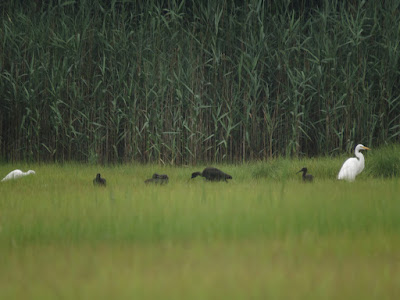I put in on the Menunketusuck River at the usual spot, a half mile below Chapman Pond and a couple miles above the sea. The tide is just starting to come in. There is a thick overcast and it begins to mist as soon as I settle in the canoe. It will mist and sprinkle almost the entire time that I am out. It is much more comfortable than living in the heat and humidity that would come with any sun.
An Osprey is perched at the first bend, and I flush a Green Heron at the second, which flies up and disappears into the tree tops. It is calm and still, and I do not expect to see anyone else.
The marsh is narrow in this upper section, 50-70 yards of spartina on either side of the river until it comes up against a hardwood forest. Near Opera Singer Point the marsh spreads out. A lot of birds prefer this area, probably both because of the distance to the trees and the better feeding due to the many small channels and pannes.As I turn one of the bends, I find thirty some white birds on either side of the river. A few are Great Egrets - noticeably larger with a bright yellow bill, several are Snowy Egrets, identified by the yellow feet and black bill, and the others, perhaps half of them, are young Little Blue Herons - the size of Snowy Egrets, but with greenish legs and feet and without a pure black bill. One of the theories as to why young Little Blues are white is that they can mix with Egrets, a safety in numbers thing. There is one morphing Little Blue as well - its feathers patchy white and blue as it becomes an adult.
 |
| Left to right - Little Blue Heron, Little Blue Heron, Snowy Egret, Great Egret |
If someone told me that they wanted to see a Glossy Ibis or a Little Blue Heron, this is where I would send them. I don't know if it is real, but it seems to me that the population of Little Blues and Glossy Ibises has been increasing in this marsh.
 |
| Little Blue Heron morphing to adult |
On the way back, three Glossy Ibises fly past, one seems to be being chased by a mature Little Blue Heron.
With a few more inches of tide, I can now scan across the broad spartina flats. I find four more Glossy Ibises on river left feeding in a panne with a few Egrets.




No comments:
Post a Comment